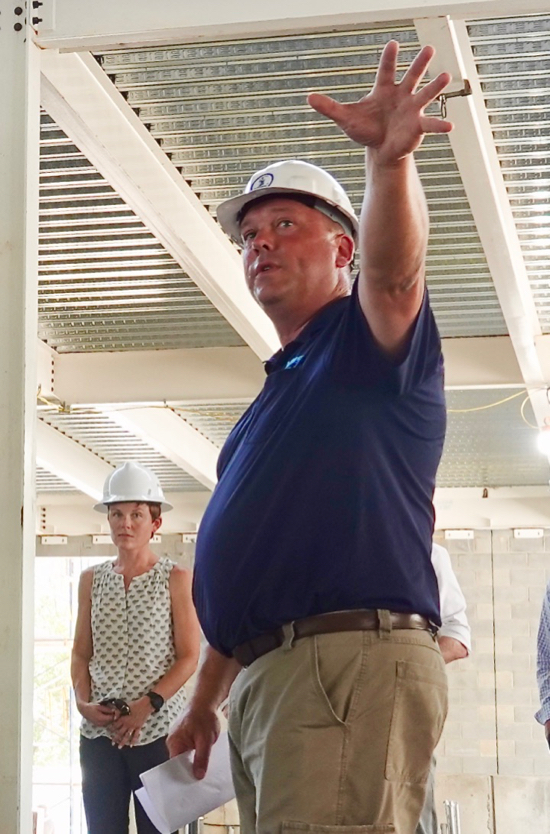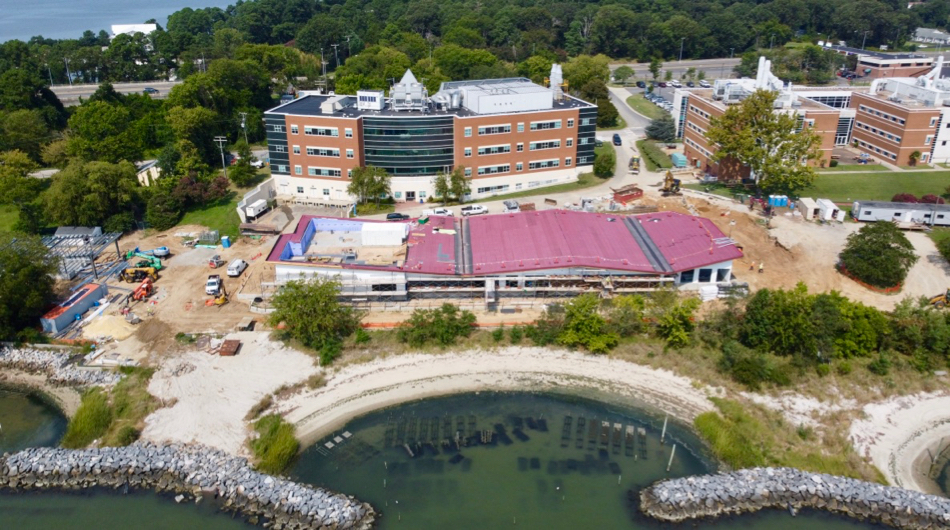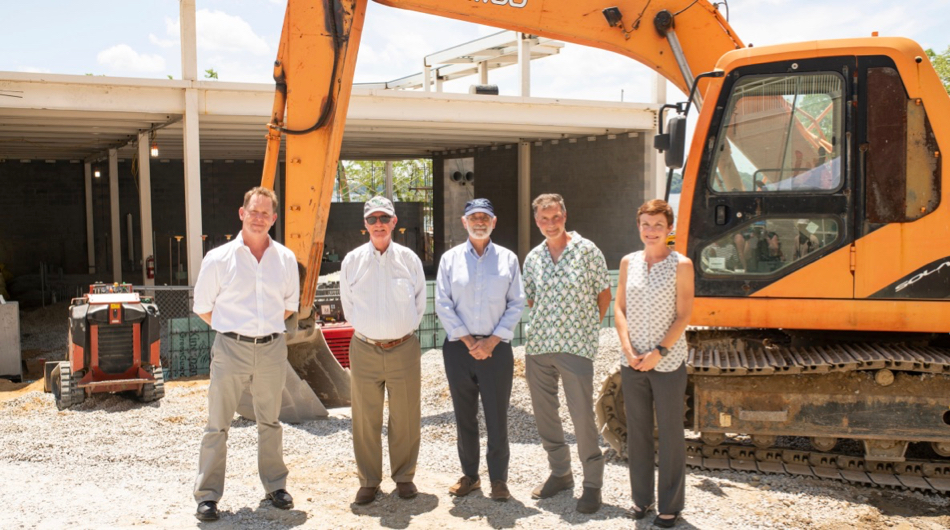VIMS’ new aquaculture facility nears completion
Editor’s note: We’re delighted to accompany our full slate of “Oystober” programming with a pair of articles that each explore an exciting advance in shellfish aquaculture at VIMS. The first introduced Dr. Bill Walton, recently hired as Acuff Professor of Marine Science and coordinator of our new Shellfish Aquaculture Program. The second article, below, highlights our Acuff Center for Aquaculture, the new home for VIMS’ Shellfish Research Hatchery.
Acuff Center for Aquaculture purpose-built to support the science of shellfish farming
Nearing completion on the Gloucester Point campus of William & Mary’s Virginia Institute of Marine Science is the Acuff Center for Aquaculture, a facility purpose-built to advance the science of farming shellfish. The expected occupancy date is spring of 2022.
The 22,000-square-foot, state-of-the-art facility will house a shellfish research hatchery designed to accommodate the operation of VIMS’ Aquaculture Genetics and Breeding Technology Center (ABC), plus several of the other research, education, and advisory teams collaborating within the institute’s recently established Shellfish Aquaculture Program.
 Dr. Derek Aday, VIMS Dean & Director, says “the Acuff Center will position Virginia to advance as a global economic leader in sustainable shellfish aquaculture.” Funded by the Commonwealth, the $22M facility honors the exceptional leadership and generosity of A. Marshall Acuff, Jr. ’62, L.H.D. ’07, P ’93 on VIMS’ behalf and in memory of his father.
Dr. Derek Aday, VIMS Dean & Director, says “the Acuff Center will position Virginia to advance as a global economic leader in sustainable shellfish aquaculture.” Funded by the Commonwealth, the $22M facility honors the exceptional leadership and generosity of A. Marshall Acuff, Jr. ’62, L.H.D. ’07, P ’93 on VIMS’ behalf and in memory of his father.
“The Acuff Center has tremendous potential and we’re all really looking forward to seeing it up and running,” says ABC associate director Dr. Jessica Moss Small. At its most fundamental level, she says, the facility will greatly enhance ABC’s core mission. “We’ll use it,” she explains, “to create genetically distinct groups of oysters for our ongoing breeding work, as well as other grant-funded projects. For ABC, the hatchery will produce hundreds of unique groups of oysters every year, many of which will eventually go to industry as brood stock.” VIMS’ production of spawnless brood stock, pioneered by now-emeritus professor Stan Allen, was the catalyst for Virginia’s now rapidly growing oyster aquaculture industry.
 Small cites several features of the new facility as particularly beneficial, especially as they compare to the hatchery it will replace. Constructed in 1975, that building is now both undersized and outmoded.
Small cites several features of the new facility as particularly beneficial, especially as they compare to the hatchery it will replace. Constructed in 1975, that building is now both undersized and outmoded.
Small says “The Acuff Center will provide highly filtered seawater water via computer-operated pumping and filtration systems at optimal temperatures to grow algae and oyster larvae, and lots of floor space and larval tanks so that production isn’t limited or stalled due to space constraints. It will also enable us to do all our spawning work in a single facility, creating valuable efficiencies in personnel and resources.”
Climate control for hatchery staff is an added bonus that will be greatly appreciated by anyone who has sweated through a summer afternoon in the existing facility. “That seems basic,” says Small, “but is really needed.
 Dr. Bill Walton, Acuff professor of marine science and Shellfish Aquaculture Program coordinator, is also excited to see the facility open. “The Acuff Center will allow VIMS to better serve stakeholders in several ways,” he says. “First, it will allow us to conduct experiments in systems comparable to what growers currently use, and thus position us to conduct more research at a ‘real-world’ scale. Second, it will be an ‘open-source’ hatchery available to stakeholders to see and assess new systems. Third, it will be a premier training ground for those interested in shellfish aquaculture.”
Dr. Bill Walton, Acuff professor of marine science and Shellfish Aquaculture Program coordinator, is also excited to see the facility open. “The Acuff Center will allow VIMS to better serve stakeholders in several ways,” he says. “First, it will allow us to conduct experiments in systems comparable to what growers currently use, and thus position us to conduct more research at a ‘real-world’ scale. Second, it will be an ‘open-source’ hatchery available to stakeholders to see and assess new systems. Third, it will be a premier training ground for those interested in shellfish aquaculture.”
Both Small and Walton express particular enthusiasm for the collaborative opportunities the new facility will offer. “With the Acuff Center,” says Small, “we’ll be able to work side-by-side as needed with collaborators in a shared space, rather than having to shoe-horn people as in our current facilities. Also, building staff can supply things like filtered water, algae, larvae, or spawning tanks to others at VIMS, so that our expertise in ABC will be available as needed for guidance.”
Walton, like Small, sees the facility’s collaborative potential as open to external partners as well. “My hope,” he says, “is that the shellfish aquaculture industry and regulatory agencies will look to VIMS when they have challenges or opportunities as a resource for information but also a partner in solving problems and providing practical tools and advice guided by the best available science.”
LEED Silver
In line with its support for a sustainable shellfish aquaculture industry, the new Acuff Center is on target for a silver certification from LEED (Leadership in Energy and Environmental Design), the world’s most widely used green building rating system. Dana Snyder, Acuff project manager, notes that LEED-certified buildings have been shown to save on energy, water, and maintenance costs, while improving employee health, productivity, and retention.
Allison Powell, an associate with project architects Quinn Evans, says “The design of the Acuff Center incorporates sustainable materials, energy-efficient systems, and a focus on indoor air quality. The project also features bird-friendly glazing and flood-resilient design which is critical to its site on the York River.”
Powell adds that the facility actually goes above and beyond LEED criteria, as its shellfish research processes make the building a living filtration system for the river itself. “Through media filters and oyster filter-feeding,” she says, “water from the York River that is pumped into the building for research use is eventually returned to the river even cleaner than it was before.”





